Leopard geckos are very popular reptile pets and a good choice for first time reptile owners.
Are you about to bring your baby leopard gecko home or are you thinking of buying a baby leopard gecko?
Continue reading for everything you need to know from bringing your new pet home to handling.
Are Baby Leopard Gecko Good Pets?
Leopard geckos are excellent reptilian pets for the whole family.
Baby leopard geckos are easy to care for, they are not fussy eaters and will eat a variety of foods. They are docile natured and are happy being handled by adults and children.
They are pretty geckos and have long life spans, they are known to live for up to 20 years or more, making them long term commitments.
Bellows are pros and cons of having a baby gecko.
Pros
- Pretty looking gecko
- Friendly, docile, gentle
- Wide choice of morphs
- Inquisitive
- Easy to care for
- Good eaters, enjoy a varied diet
- Long life spans
Cons
- Drop tails when grabbed
- Poop without warning
- Can get lost at home due to exploratory behavior
| Baby Leopard Gecko Quick Facts | |
|---|---|
|
Common Name |
Leopard gecko |
|
Scientific Name |
Eublepharis macularius |
|
Baby Size |
3 – 5 inches long, up to 20 grams |
|
Adult Size |
Female 7 – 8 inches, male 8 – 10 inches; weight from 60 to 120 grams |
|
Lifespan |
10 – 20 years |
|
Tank Size |
10 – 20 gallons |
|
Humidity |
30% – 40% |
|
Heating |
70ºF – 95ºF |
|
Substrate |
Reptile carpet, paper towel, newspaper, tiles, and shelf liners |
|
Hides and Accessories |
Warm hide, cool hide and humid hide |
|
Diet |
Insects |
|
Supplement |
Calcium and multivitamin |
Choosing a Healthy Baby Leopard Gecko
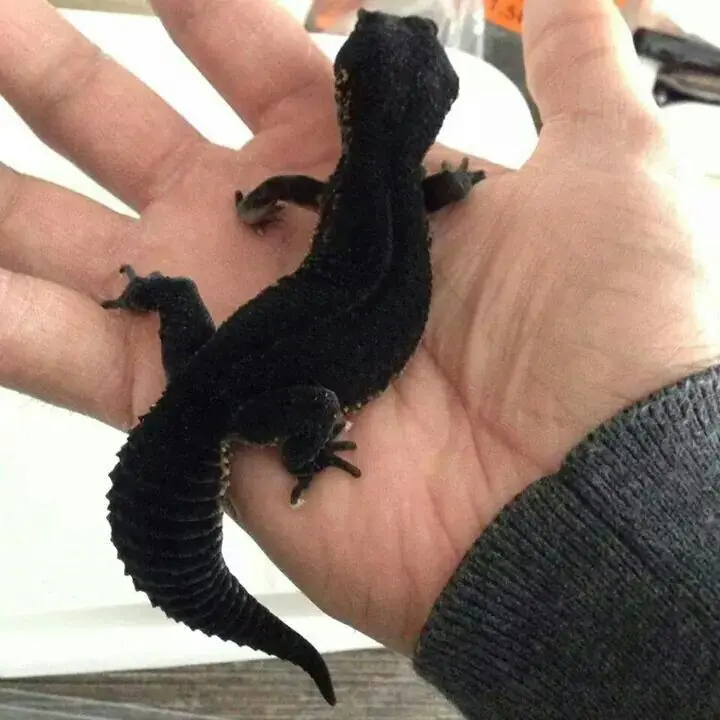
Melanistic leopard gecko
You can expect to pay anything from $30 to over $100 for a baby leopard gecko based on the morph you select.
When it comes to selection, there are some very important factors to take into consideration.
The tail and spine should be straight and the gecko shouldn’t have any toes missing. Missing toes is often a sign of overcrowding, which means minimal food options and this can cause health issues in the future.
When you look at the baby leopard gecko, there should be no bones visible, and its tail should be found and plump with a clean belly and no signs of feces.
Take a minute to look in the enclosure where the gecko is being housed and check the feces, which should be dark in color, soft in consistency, and look like little pellets.
Note that some morphs such as enigma and lemon frost are considered problematic and should be avoided. Therefore, before bringing a leopard gecko home, make sure you know the list of problematic morphs.
Baby Leopard Gecko Growth Rate
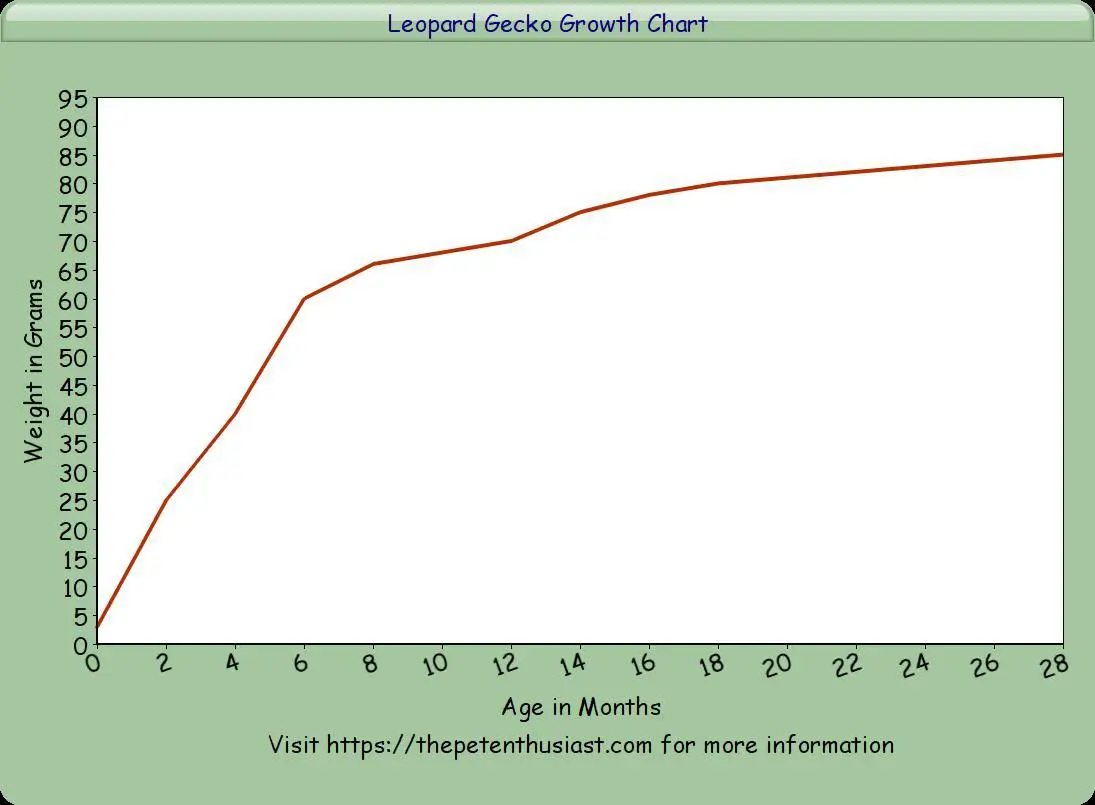
|
Age | Weight |
|---|---|
|
Hatching | 3 – 4.5 grams |
| 1 month |
15 – 20 grams |
|
2 months | 18 – 30 grams |
| 4 – 6 months |
25 – 60 grams |
|
9 – 18 months |
40 – 110 grams |
1 Month Old – Just Hatched
The gecko climbs out of the egg and is then moved to a plastic terrarium. They will shed for the first time between five to seven days.
Once they reach one month they can be moved to a larger cage, when you know they are feeding and shedding properly.
1 Month to 3 Months
The leopard gecko will start eating at this stage as they shed more frequently. They grow at a rapid rate at this age. To aid with shedding add some sphagnum moss to the moist hid box.
They need plenty of calcium powder to assist with proper bone development.
3 Months to 6 Months
At this age, it’s normally the time you can sex the leopard gecko. Males should not be kept with other males from this age, as they tend to get territorial.
Baby leopard geckos can be housed in adult sized enclosures from this age. Note that we don’t recommend cohabitat.
6 Months to 12 Months
At this age, the baby leopard gecko is on its way to being an adult. Keep females away from males to reduce them breeding too early, which can be dangerous for a baby leopard gecko.
Related – See a complete growth chart of a leopard gecko here.
Baby Leopard Gecko Habitat Setup
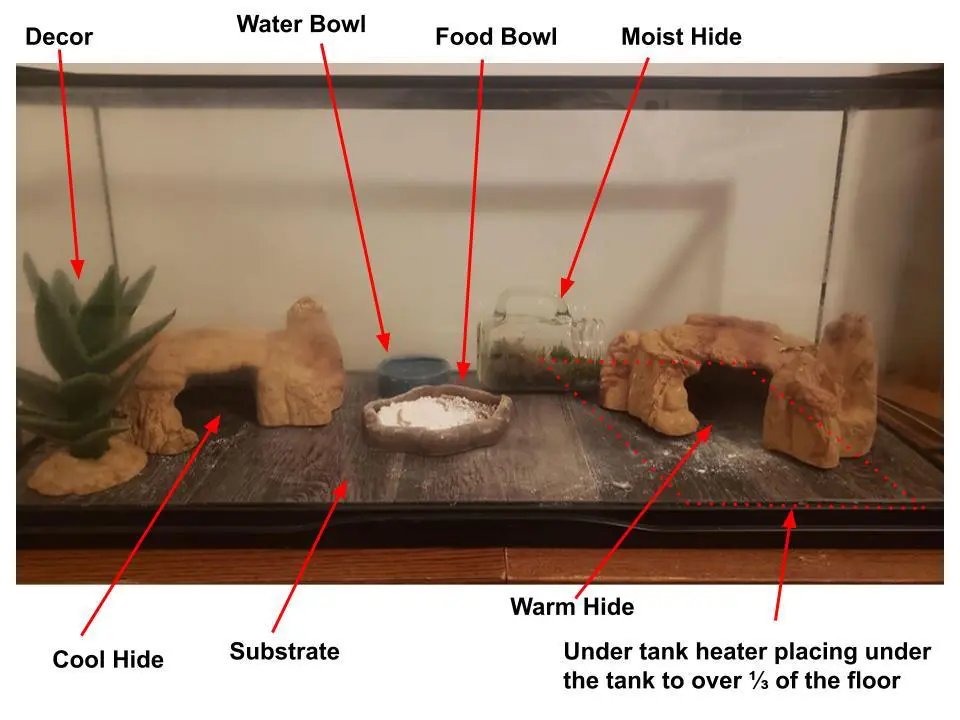
A simple leopard gecko setup
Tank
A baby leopard gecko can be housed in a 10 to 20 gallon glass enclosure.
It’s not uncommon for plastic terrariums to be used for newly hatched geckos, but at the rate they grow, you can put them in an adult enclosure from the age of three months.
If you want to house a male and female together for breeding purpose, then choose at least a 20 gallon enclosure.
Related –Best leopard gecko enclosure.
Substrate
There are many great substrates on the market for leopard geckos.
Of course, any selection you make you need to ensure that you reduce the risk of impaction, which can be caused by your gecko eating some substrate when catching prey, which can cause constipation.
Reptile carpet, paper towel, newspaper, tiles, and shelf liners are the most popular substrate options.
Be careful of small pebbles and sand substrates, which can result in impaction.
Lighting and Heating
Leopard geckos get their vitamin D from their diet. Therefore, you don’t need to worry about a UV light for your new reptile pet.
However, your gecko will need some light to simulate a day and night cycle. Light should be on for 12 hours and off for 12 hours.
Leopard geckos have very strict temperature requirements, as below:
- Hot side of the tank – 85 – 94ºF (32 – 34ºC)
- Cool side of the tank – above 70ºF (21ºC)
- General air temperature – 77 – 85ºF (25 – 29ºC)
Related – Learn how to keep ideal temperature in a leopard gecko tank.
Humidity
Leopard geckos enjoy a low humidity of 30% to 40%, which can be achieved by adding a water dish to the warm side of the enclosure to misting regularly to increase humidity levels.
Remember to monitor humidity levels regularly using a digital hygrometer.
When the humidity is too high or too low for extended periods of a few days, it can cause serious health issues.
Hides and Accessories
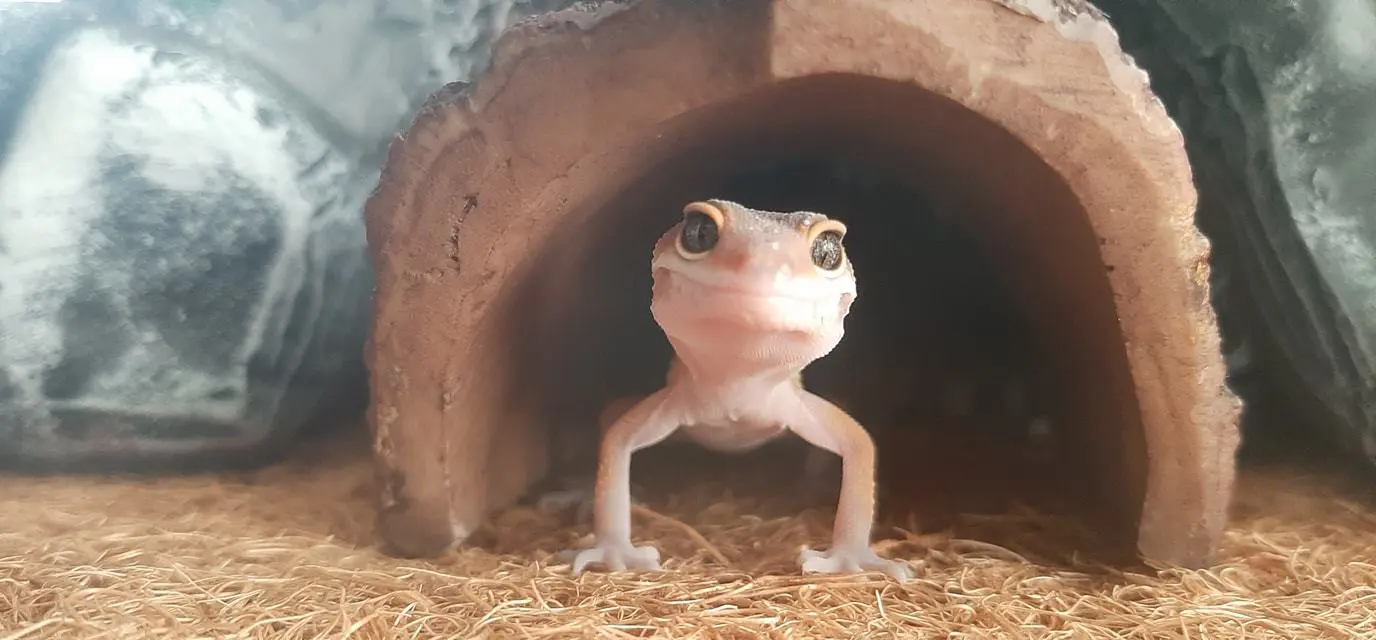
Leopard geckos are naturally inquisitive and they will spend their nights exploring their enclosure, which is why you want to provide a number of hides and accessories to keep your gecko happy and entertained.
You will want three hides in your gecko’s enclosure.
One will be the warm hide, placed on the hot side of the enclosure. Often you can find a hide and basking platform in one accessory which can save on space.
The middle hide will be the humid hide and should include sphagnum moss, aiding with shedding.
Then the last hide is to be placed on the cool side of the enclosure, which enables your gecko to regulate its body temperature, moving to a cool hide when it is too hot.
In addition to this, you will want to add some rocks and plants to complete the enclosure design and provide your gecko with a comfortable and safe habitat.
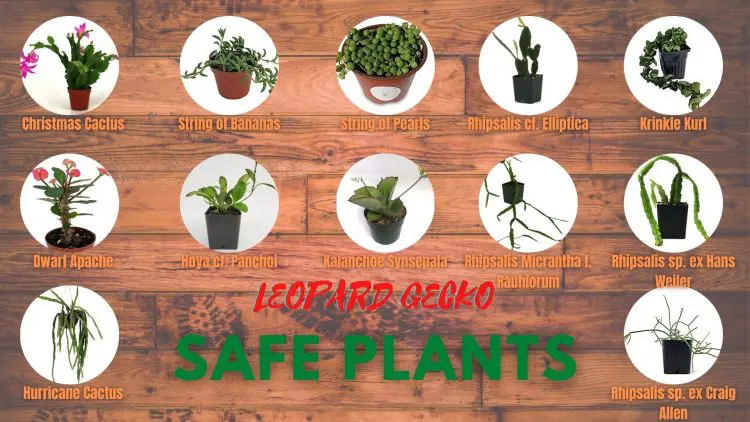
Safe plants for leopard geckos
Baby Leopard Gecko Diet and Supplement
Baby leopard geckos have a set required diet and will need some supplementation to ensure that their health is maintained and that their bones grow strong and healthy.
Food
Leopard geckos enjoy a varied diet, but they are happy eating only crickets and some mealworms as their staple food.
In addition to this, you can feed your geckos superworms, dubia roaches, wax worms, hornworms, silkworms, and phoenix worms as treats.
Baby leopard geckos can eat the same diet as adults, except that it can be harder to find the food small enough for them to eat without choking.

Dubia roaches are good staple food
Supplements
Leopard geckos need a vitamin supplement with every meal they consume and this is even more important for babies, which are still growing and need strong bones.
Calcium deficiency is a serious issue for leopard geckos and if ignored, it can result in metabolic bone disease, which causes problems with the skeletal structure, resulting in deformities, injuries, and death.
Calcium powder is easy to use and effective.
Baby Leopard Gecko Feeding
How Often Do I Feed a Baby Leopard Gecko?
Baby geckos should be fed every day. At this young stage, they are growing at a rapid rate and need the vitamins and minerals to assist with this growth.
Once they reach adult age, they can be fed every second day.
How Much Do You Feed a Baby Leopard Gecko?
A rule of thumb when it comes to feeding your baby leopard gecko is that it should be given two insects for every inch in length. So, a 3 inch baby leopard gecko needs 6 insects per meal.
Feeding Schedule
It’s recommended to feed your baby leopard gecko late in the day or early evening when they are most active and would be naturally hunting for food in the wild.
Gut Loading
Gut loading is a process of feeding your crickets a high calcium meal before you feed them to your leopard gecko.
This ensures your gecko gets all the essential vitamins and minerals it needs with each meal.
What Insect Size for a Baby Leopard Gecko?
It’s not always easy to identify the size of insects you should be feeding to your baby leopard gecko, but remember if the food is too big, it can result in choking or impaction.
The cricket or insect should not be any bigger than the space between your leopard gecko’s eyes.
Why is a Baby Leopard Gecko Not Eating?
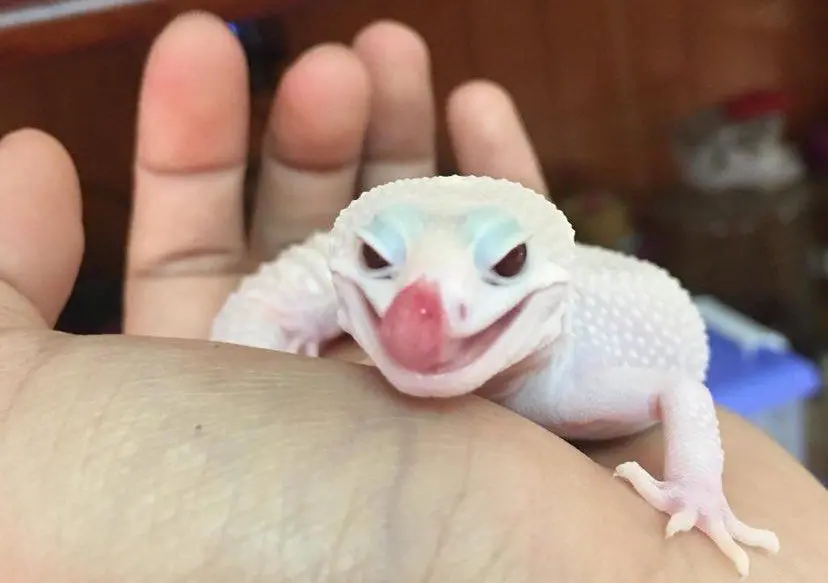
It’s not uncommon for your baby leopard gecko to refuse food when it first comes into your home. They need time to adjust to a new environment.
For this reason, your gecko may not eat for up to one month after arriving in its new home.
Another problem could be that you are feeding different food to what the breeder was feeding.
Try a variety of foods from crickets to mealworms and waxworms.
Try smaller worms that can be eaten by the baby leopard gecko with ease.
Bear in mind that baby leopard geckos shed regularly and they don’t eat before they shed. If your gecko’s skin is going white, it could be getting ready to shed and has lost its appetite until the shedding process.
Your baby leopard gecko may have a parasitic infection, impaction, or another illness which is causing it to lose interest in food.
The final reason your baby leopard gecko could be refusing food is that the temperatures are too low.
Ensure you monitor your enclosure temperatures with a digital thermometer for easy and accurate monitoring.
You can encourage your baby leopard gecko to eat by turning off the lights, embracing natural hunting behaviors rather than hand feeding, monitoring temperature, and changing their diet.
Can Baby Leopard Geckos Live with Adults?
Maybe you already have an adult leopard gecko and are keen on getting another. Remember that it’s not uncommon for adult geckos to eat the young, especially after birth.
Baby leopard geckos should be separated from adults to avoid injury. Unfortunately, leopard geckos will eat anything that can fit in their mouth.
Baby Leopard Gecko Shedding
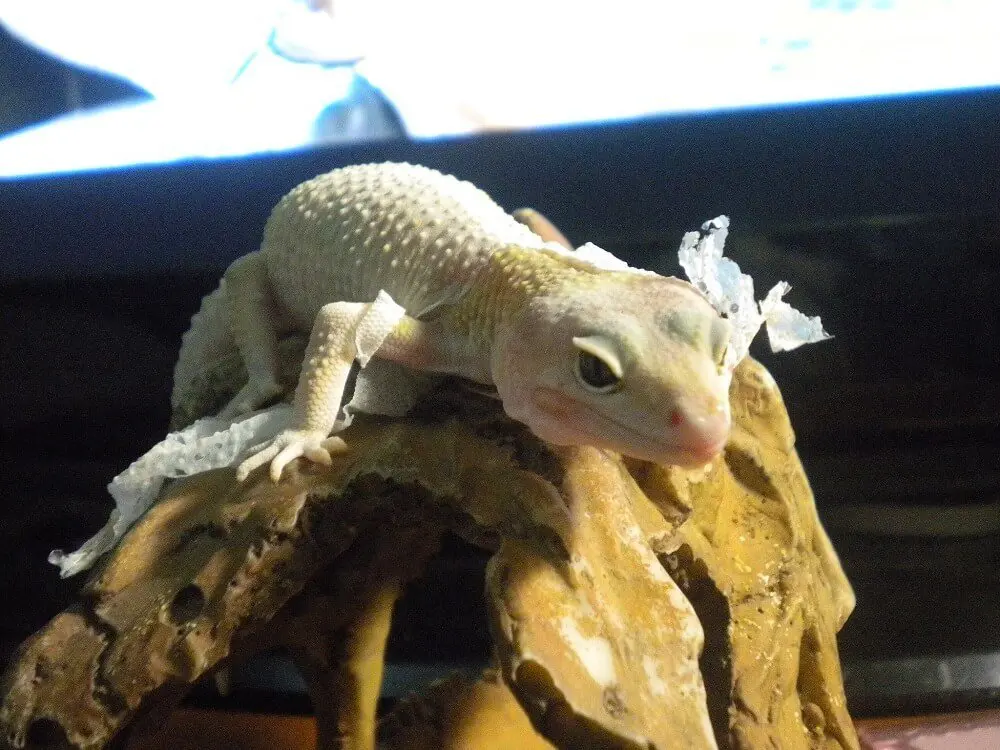
Leopard gecko shedding
Baby leopard geckos grow considerably faster than the adults. Babies will shed within 5 to 7 days of hatching and will shed once every 1 to 2 weeks until they reach adulthood.
You can quickly tell when your baby leopard gecko is about to shed, your gecko’s colors will become dull and the skin will separate, turning white. Once your gecko sheds, it will eat the skin.
Baby Leopard Gecko Handling
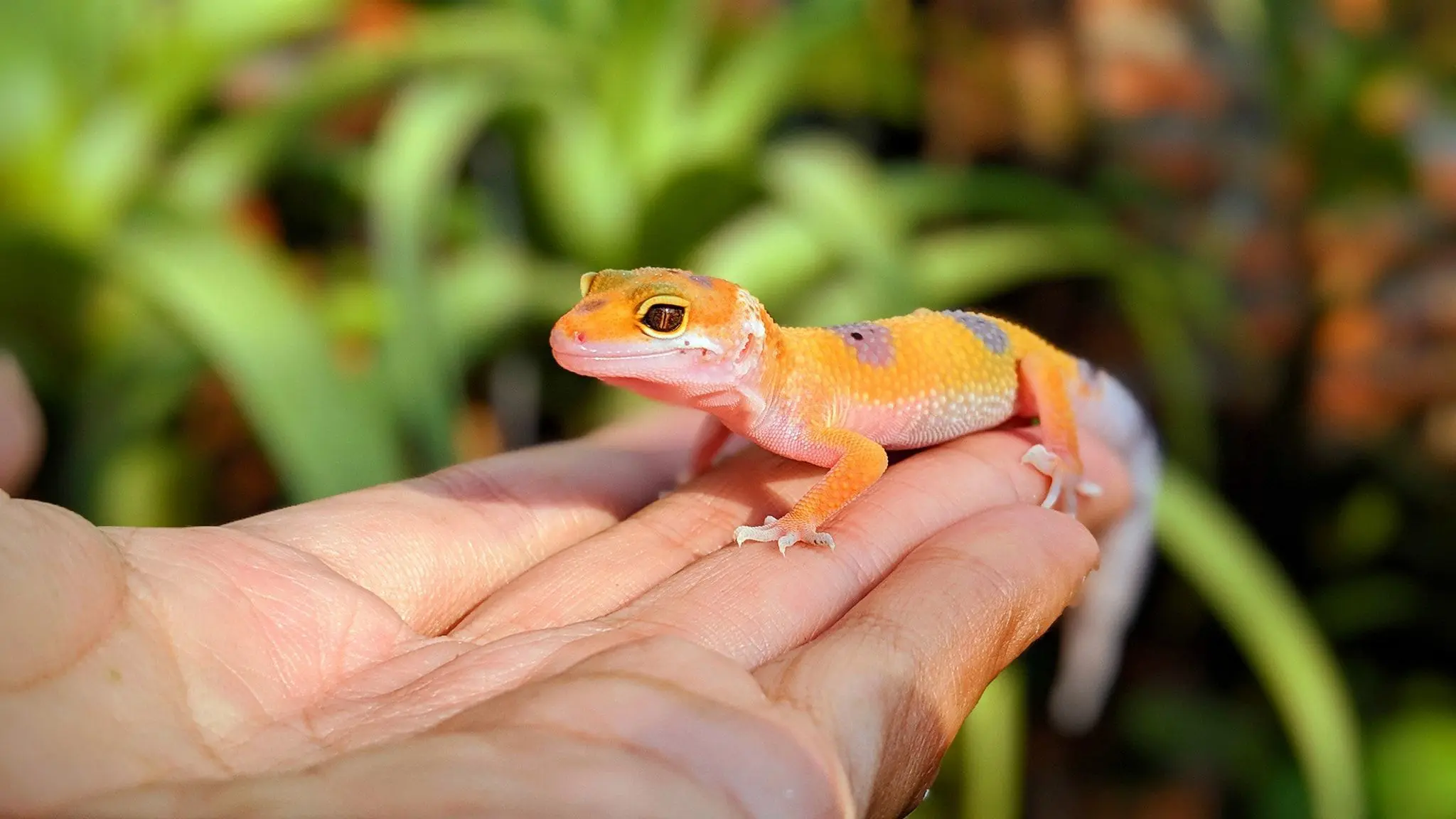
Of course, as you would with a kitten or puppy, you want to play with your new gecko when you bring it home.
It’s recommended you wait at least two weeks before you start your handling process.
This helps your baby leopard gecko to get used to its new home and reduce its stress associated with the move. Do not start handling your gecko until it starts to eat.
Don’t immediately pick up your gecko after the two weeks, that is just going to cause undue stress. Rather let your gecko get used to you.
You can do this by putting your hand in its enclosure in the evenings. When your gecko is used to you, you can scoop it up, letting it climb over your hands. Stay close to the ground, as these geckos can jump.
How to Tame a Baby Leopard Gecko?
Here are six tips to help you tame your baby leopard gecko with ease.
Move Slowly
The first tip to tame your baby leopard gecko when you bring it home is never to do anything too fast. Move slowly, whether it’s putting your hand in the enclosure to get it used to your presence or you want to scoop it up to handle.
No Surprises
Always approach your gecko from the front, never surprise it.
Remember your gecko can bite, even though it won’t be sore.
Surprising your gecko can set you back one or two paces, so rather move slowly and from the front for best results.
Only Handle for Short Periods
When first handling your leopard gecko it’s recommended to only handle it for around 5 minutes at a time until it gets used to you.
This helps reduce stress, which can help your gecko become tamer faster.
Keep Your Gecko Secure
It’s important when you scoop your gecko up, that you hold it firmly and safety in your hands without squeezing.
This will reduce the risk of your gecko jumping out of your hands and injuring itself.
Never Grab by Tail
It’s imperative that you never grab your leopard gecko by the tail, which may be tempting when you’re trying to pick it up and it runs off to one of its hides.
Grabbing the tail will cause your gecko to automatically release its tail.
Wash Your Hands
Your hands should be washed before and after handling your gecko.
Wash with fresh water and ensure there isn’t any soap or lotion residue on your hands when handling your reptile pet.
when does your leopard gecko shed
Baby leopard geckos will shed every 10 days because they grow fast during this stage. After reaching adulthood, the shedding period is 4-6 weeks
My little gecko only eats every few days he’s very picky and still new to his home my other gecko isn’t much bigger she has MBD cause of her last owner but they both get calcium now and MBD is getting better she can barely lift herself up but its progress but anyways my geckos don’t eat that often for some reason I’ve had one since last christmas and the other not even a month both are almost the same size. My first one was almost dead when I received her but she also has. Lost her color since I got her from her owner she sheds but her color is gone she’s always pale. Her last owner didn’t give her food water or the right heating her tail was pulled off by a toddler in her last home. I hope shew not sick.
I am so sorry, but the discoloration could be from her aging…..But maybe not, it might be best to take her to the vet, because I’m not a professional.
And about your other baby gecko…..Leopard geckos are picky this is common, so nothing to worry about, he also might just be adjusting to the new home move, hope I helped <3
Have a great day!
sincerely,
Fellow Gecko Lover
Thank you so much, i just got my new baby, Neji, and this helps ALOT!